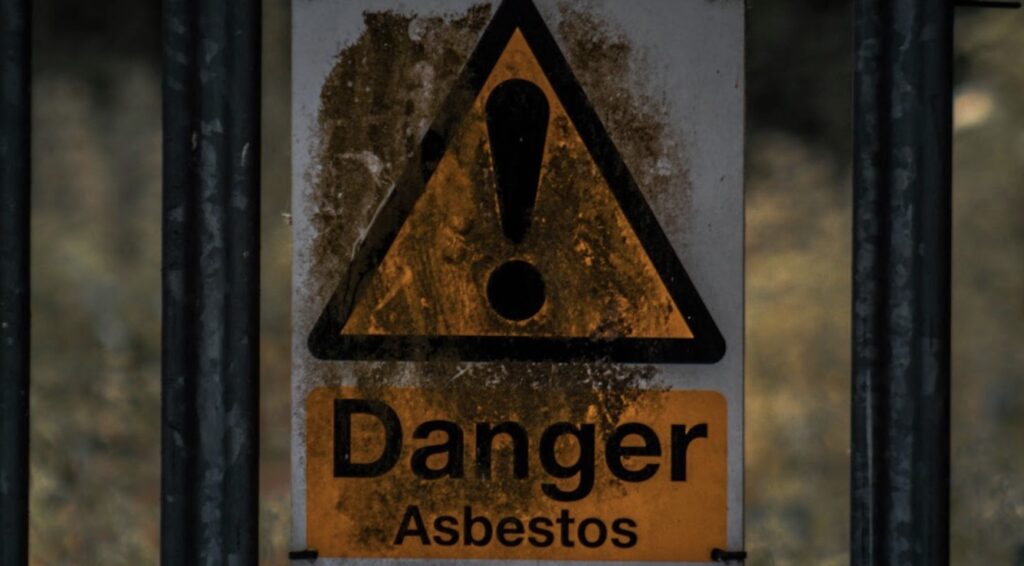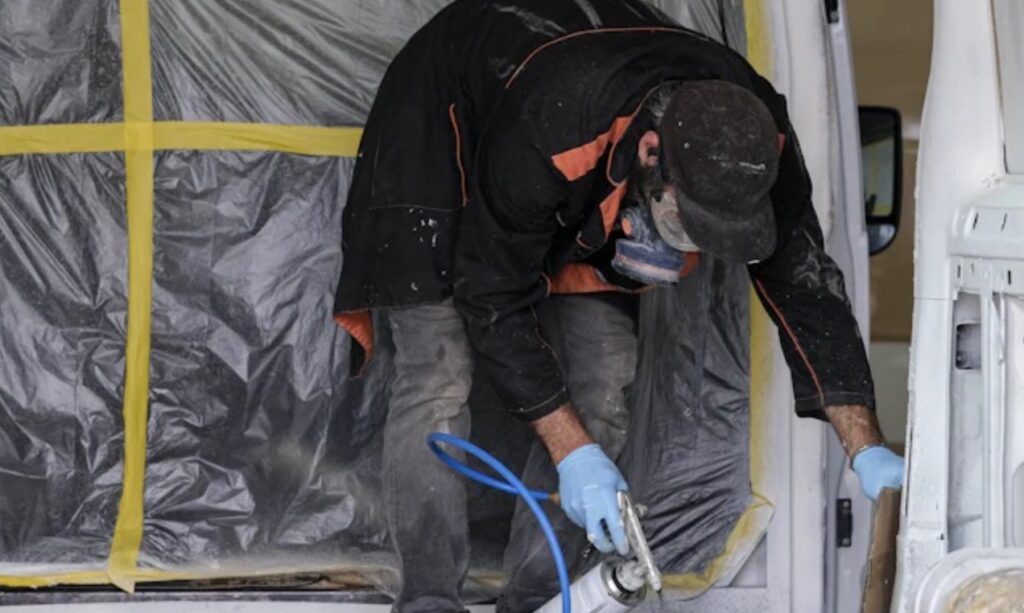Asbestos removal in the UK is governed by strict safety and legal standards under the Control of Asbestos Regulations 2012 (CAR2012).
Whether in a domestic or commercial setting, proper removal involves more than just physical extraction—it includes surveying, licensing, containment, air testing, and waste disposal.
This guide outlines the full process step-by-step, helping duty holders and contractors carry out asbestos removal safely, legally, and efficiently.
Pre-Removal Asbestos Survey & Testing
Before any asbestos removal begins, a licensed asbestos survey must be commissioned to locate and assess all asbestos-containing materials (ACMs) on-site.
This typically involves a refurbishment and demolition (R&D) survey, where trained professionals identify suspect asbestos-containing materials and collect bulk samples. These asbestos samples are analysed in UKAS-accredited laboratories using polarised light microscopy (PLM) or, where needed, scanning electron microscopy (SEM).
Survey results include detailed mapping of ACM locations and risk ratings, which shape the asbestos removal strategy, safety protocols, and legal notifications required under CAR2012.
Notification & Licensing For Asbestos Removal
Under the Control of Asbestos Regulations 2012 (CAR2012), any non-licensed asbestos work exceeding 10 m² becomes notifiable to the Health and Safety Executive (HSE) as Notifiable Non-Licensed Work (NNLW).
Additionally, work involving friable ACMs or high-risk tasks—such as removal of pipe lagging or sprayed coatings—must be carried out by a licensed asbestos contractor.
Notifications include project location, description of ACMs, method of removal, worker details, and asbestos safety controls. Licensed asbestos projects typically require a 14-day notification period before work can commence.
Demarcation of Asbestos-Containing Area & Evacuation
To prevent cross-contamination, the asbestos work area must be fully sealed and clearly demarcated, which includes erecting physical barriers, posting statutory warning signage, and isolating ventilation systems (HVAC).

Nonessential personnel must be evacuated, and adjacent rooms or walkways must be secured and monitored to ensure asbestos fibre containment. Entry and exit routes for authorised staff should be clearly defined and controlled.
Asbestos Containment Setup
A negative-pressure enclosure is constructed around the asbestos work zone using polythene sheeting and a steel or timber frame. Air extraction units fitted with HEPA filters maintain inward airflow to prevent asbestos fibres from escaping.
Decontamination units—comprising a clean room, shower unit, and dirty room—are installed at the enclosure’s entry point. Airlocks and pressure monitors ensure the asbestos-affected area remains sealed and under safe pressure. Emergency exit procedures and communication systems must be tested before work begins.
Personal Protective Equipment & Safety Protocols For Asbestos Removal
All asbestos-managing personnel must wear certified PPE, including P3 half- or full-face respirators, disposable Type 5/6 coveralls with hoods, rubber gloves, and anti-slip boots.
Asbestos safety protocols require buddy systems for donning and doffing PPE, with staff checking for correct fit and sealing.
To ensure safe exit from the asbestos work area, workers must follow these decontamination steps after each shift or re-entry:
- Step 1: Dirty Room – Remove disposable overalls, boots, and gloves. Place all PPE in designated asbestos waste bags.
- Step 2: Shower Unit – Shower thoroughly to remove any residual fibres from skin and hair.
- Step 3: Clean Room – Exit into the clean area and dress in uncontaminated clothing.
Key Techniques for Safe Asbestos Removal
Safe asbestos removal relies on strict methods that minimise fibre release and environmental contamination. Techniques vary based on material type and condition, focusing on maintaining the integrity of bonded ACMs during extraction.

From wet stripping and glove bag isolation to intact panel asbestos removal and precision vacuuming, each method serves a specific control function. These procedures collectively ensure asbestos fibres remain contained throughout the removal process.
Wet Stripping for Bonded Materials
Surfaces such as vinyl floor tiles, ceiling panels, and bonded cement sheets are first saturated with amended water—water mixed with a non-ionic surfactant—to suppress asbestos fibre release.
Using low-pressure sprayers, applicators thoroughly wet the ACM to create a film that traps loose asbestos fibres. Materials are then gently pried away by hand or with a blunt scraper, ensuring that asbestos-containing pieces come out intact rather than fragmenting.
Continuous misting during removal keeps airborne asbestos fibres to a minimum, and any runoff is collected and treated as asbestos waste.
Glove Bags for Pipework and Small Components
For isolated sections of lagged pipe or small asbestos-cement fittings, preformed glove bags provide a sealed environment. The technician slips the bag over the section, securing its collar around the pipe or component with tape or clamps.
Built-in gloves allow internal manipulation—cutting, stripping, or unscrewing—without breaching asbestos containment. Once the ACM is fully detached inside the bag, it is sealed off, and the entire asbestos-containing assembly is removed, double-bagged, and labelled for disposal, ensuring zero fibre escape.
Sheet or Panel Removal for Non-Friable ACMs
Larger bonded sheets—such as ceiling tiles, wall boards, or roofing panels—are best removed in whole sections of asbestos-infected areas. Using manual lifting tools (e.g., suction lifters, panel lifters) and hand tools to loosen fixings, installers detach each asbestos-contaminated sheet intact.
Careful handling avoids cracking or breaking, which would release asbestos fibres. Removed panels are immediately placed on pre-lined trays or sheets, which are then sealed in labelled asbestos waste bags, preserving the bound state of the material and preventing fragmentation.
HEPA Vacuuming of Residual Debris
Throughout asbestos removal and during the final clean-up, certified HEPA-filtered vacuums (compliant with BS EN 60335-2-69) are employed to capture any loose dust or stray asbestos fibres.
Technicians use crevice tools and soft-bristled brushes to dislodge asbestos debris from joints, corners, and surfaces, vacuuming as they work. After bulk asbestos removal, a full secondary vacuum pass is conducted over floors, work surfaces, and equipment.
Filters are inspected and replaced according to manufacturer guidelines, and all collected asbestos waste is treated as hazardous ACM.
On-Site Asbestos Cleaning & Decontamination
After ACMs are removed, all internal surfaces, tools, and enclosures containing asbestos must be cleaned using damp, disposable cloths. Contaminated water used to remove asbestos and cleaning must be captured and disposed of under environmental regulations.
Any reusable tools are double-bagged, labelled, and transported for specialist off-site asbestos decontamination. The site is only considered clean once no visible asbestos debris remains and post-cleaning inspections are passed.
Air Monitoring & Clearance Testing For Asbestos
During asbestos removal, air quality is monitored in real-time using static or personal samplers to detect airborne asbestos fibres.
After works are completed, clearance air sampling is conducted under controlled conditions. To pass, asbestos fibre levels must not exceed 0.01 fibres per cubic centimetre (f/cm³). If this threshold is met, a UKAS-accredited asbestos analyst issues a Certificate of Reoccupation, allowing safe re-entry.
Asbestos Waste Packaging, Transport & Disposal
All asbestos waste is double-bagged using red inner and clear outer bags labelled in accordance with CAR2012. Rigid packaging may be used for larger asbestos fragments or boards.
Asbestos waste must be documented using a hazardous waste consignment note and transferred by a licensed carrier to an authorised asbestos disposal site.
Cost for this asbestos removal process ranges from £200 to £500 per load depending on volume and location. Temporary on-site storage must meet asbestos containment standards and be limited to short durations.
Final Site Handover & Asbestos Documentation
Upon completion, a full project file is compiled, which includes:
- Updated asbestos register – Reflects all removed and remaining ACMs with new condition data.
- Survey and lab test results – Original pre-removal assessments and laboratory analysis reports.
- Removal method statements – Detailed accounts of techniques, safety protocols, and equipment used.
- Photo log – Visual documentation of removal stages, enclosure setup, and final condition.
- Clearance certificates – Issued by UKAS-accredited analysts after successful air monitoring.
- Waste transfer documentation – Consignment notes and licensed carrier details for disposal.
- Record retention – All records must be kept for at least 40 years for legal and compliance purposes.
- Management plan update – Remaining ACMs must be integrated with revised inspection schedules and risk ratings.
